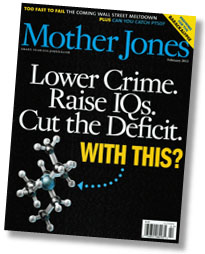 For the past couple of weeks I’ve been writing updates of various kinds to my article about the link between gasoline lead and violent crime. A reader suggested that I should collect everything in one place for ease of reference, and I thought that sounded like a good idea. So here it is.
For the past couple of weeks I’ve been writing updates of various kinds to my article about the link between gasoline lead and violent crime. A reader suggested that I should collect everything in one place for ease of reference, and I thought that sounded like a good idea. So here it is.
Criminal Element. This is the original piece spelling out the detailed evidence that the rise and fall of gasoline lead in the post-World War II era was responsible for the rise of violent crime starting in the 60s and its subsequent decline starting in the 90s.
The story in a nutshell. Provides a brief version of the lead-crime story as an introduction to the full article.
It’s not just lead. Emphasizes that lead is a major part of the crime story, but not the only part. Also: audio of my appearance on the Leonard Lopate show explaining the lead-crime connection.
The prison population is dropping. Declining exposure to lead starting in the mid-70s reduced the rate of violent crime 20 years later. Twenty years after that, as members of Generation Lead are being released from prison and aren’t being replaced, the prison population has started to drop too.
Lead and murder. We have fairly good data on murder rates going back for a century, and it turns out the United States has had two epidemics of murder, the first in the 20s and 30s and the second in the 70s and 80s. When you account for both lead paint and gasoline lead, it turns out that lead can explain them both.
Crime in Chicago. Violent crime is up in certain parts of Chicago. Is lead responsible?
A response to Deborah Blum. A small correction, and another post emphasizing that although lead is an important part of the crime story, it’s not the whole story.
International crime trends. Violent crime began to drop in the United States in the early 90s, about 20 years after we began reducing the lead content of gasoline. But how about other countries? Where can we expect to see crime drops in the future?
The Melissa Harris-Perry show. Video of me talking about lead and crime with Melissa Harris-Perry. Howard Mielke, a longtime lead researcher from Tulane University, is also on the show.
How did lead get into our gasoline in the first place? The whole fascinating story is right here, along with lessons for the future.
George Monbiot and Scott Firestone. Monbiot endorses the lead-crime theory and Firestone criticizes it. I respond, along with a brief summary of the multiple threads of research that support the lead-crime hypothesis. Followup here.
Baselines vs. crime waves. Lots of things contribute to baseline levels of crime. But lead is uniquely able to explain why there was such a huge rise of crime above the baseline during the 60s, 70s, and 80s, followed by an equally huge reduction back to the baseline in the 90s and aughts.
Big cities vs. small cities. Surprisingly, it turns out that once you reduce exposure to gasoline lead, big cities aren’t really all that much more dangerous than small ones after all.
A response to Jim Manzi. This is a wonky post responding to Manzi’s generic critique of econometric analysis of complex social issues.
Crime and race. In the postwar era, black children were exposed to much more lead than white children. This explains some of the racial differences in both crime rates and incarceration rates.

















